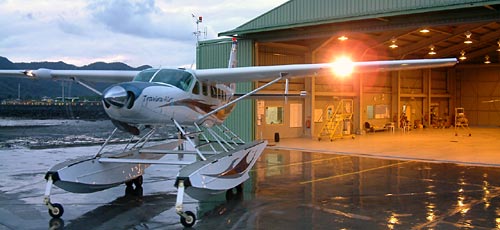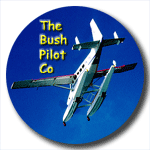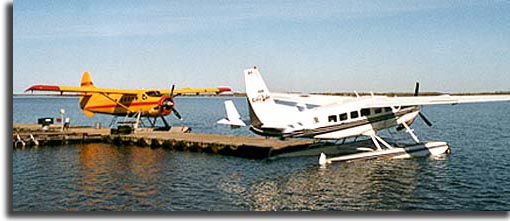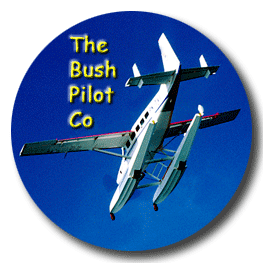The Bush Pilot Company
Providing
Information & Training Required
for Operating Modern Bush
Planes.
![]()

![]()
 How
to Take the "Bush" Out
How
to Take the "Bush" Out
of the Bush Pilot
![]() Virtual
Horizons now brings to you a new concept in bush flying. How to take the
“bush” out of the bush pilot. With today's modern and very expensive
bush planes becoming more and more prevalent pilots have to become more
mindful of today's technology. Turbine engines, FCUs, emergency power
levers, Ng and ITT Indicators, amphibious gear mechanisms, reversing
propellers, pitch locks, GPS approaches, TCAS, GPWS, stormscopes, color
radar, ground mapping, moving map displays, air conditioning, beta backup
systems, overspeed governors, and a host of other technological toys are
starting to fill the cockpit with more gizmos than the average pilot can
manage, and still aviate, navigate, and communicate.
Virtual
Horizons now brings to you a new concept in bush flying. How to take the
“bush” out of the bush pilot. With today's modern and very expensive
bush planes becoming more and more prevalent pilots have to become more
mindful of today's technology. Turbine engines, FCUs, emergency power
levers, Ng and ITT Indicators, amphibious gear mechanisms, reversing
propellers, pitch locks, GPS approaches, TCAS, GPWS, stormscopes, color
radar, ground mapping, moving map displays, air conditioning, beta backup
systems, overspeed governors, and a host of other technological toys are
starting to fill the cockpit with more gizmos than the average pilot can
manage, and still aviate, navigate, and communicate.
All these modern wonders are supposed
to make our lives safer and easier, but do they? Put all those toys into
one flying package along with some good-old-boy from the bush or the young
kid who just left his mamma at home and watch what happens. Most good
pilots are going to have a hell of a time keeping that technological
wonder that your company just paid a million bucks for moving in a
straight line, let alone figure out if that glaring red light means that
either: the engine is on fire, the battery is overheating, the generator
has gone offline, the gear is stuck halfway down, the fuel reservoir is
low, there is a bogie on the TCAS or a hill looming on the GPWS, or the
passenger in a white robe has opened the cargo door.
Oh, yeah, did I mention that this is while
he is doing a coupled ILS approach in 1/2 mile of dust haze into some
African country run by a dictator that no one outside of his country can
pronounce the name of, and the control tower has just informed the pilot
that he has violated military airspace recently placed because of an
attempted coup this morning and that the Captain will be arrested on
arrival? Now what was that red light for again?
I don't know about you, but most bush
pilot would rather be scud running in a Norseman about that time. In fact,
that scenario is not so exaggerated. A Lufthansa A340 crew had to deal
with a similar circumstance coming into the Ivory Coast not that long
ago. The pilots declared that the ILS was not working and commanded a
go-around to their alternate, which was a non-coup attempt country just 20
minutes away, and then cleaned up the red light situation by recycling the
gear. Ok, that is the big boys you argue, but that could have just as
easily been you or one of your pilots in your million-dollar turbine Otter
or Caravan.
What the difference between the
Lufthansa crew and the pilot on the Cessna Caravan will be about $250,000
worth of training. The big boys spend the money to keep their pilots as
sharp as an EFIS screen and quicker than an Inmarsat data link. The usual
scenario for when a company buys a turbine Otter or amphib Caravan,
however, is for the owner to find a high time floatplane pilot who has
time on the Otter and the King Air, and have the Chief Pilot take him
around the patch a few times. Ok, maybe your company is not that bad. They
send their King Air pilots to Flight Safety on the Caravan and then let
them loose on the amphib Caravan. Actually that could be just as bad. In
neither case is the pilot trained on the actual equipment that he is going
to fly.
The deal is that the big airlines
have plenty of options when it comes to training. All the big aircraft
have Cat C simulators for a start, with the initial and recurrent flight
training farmed out by either the manufacturer or the airline. But, what
the airlines cannot farm out they grow at home. Everyone knows that
British Airways run their own flight training academy for future
employees. And companies like American Airlines and Lufthansa run
commercial flight schools for their pilots and other paying customers.
Plus all the big airlines have a very intensive initial and recurrent
ground school that covers both technical and operational aspects of the
company's flying. There is no shortage of options for the big airlines.
What about the 5000 hour bush pilot
transiting onto a Turbo-Beaver, or a Caravan amphib? At least for the
Caravan there is the Flight Safety simulator. The simulator, however, is
for the Grand Caravan on wheels. There is no simulator for the amphib
version. Although I did have an instructor ask me to land in the Boston
Harbor in their new daytime Class C simulator. I made a safe water landing
except it was like landing in about 2 meters of fog. Only the top of the
cockpit stuck out from the fog as I taxied around in the harbor. It was
not at all realistic and it fact the wheels went squeak squeak when I
touched down. The truth is that the amphib version is different enough
that it requires a separate checkout and not just a run around the pond.
That is true for the Twin Otter
simulator as well. There is a nifty Flight Safety Simulator in Toronto
that packs realism into their full flap critical engine failure go-around
that makes you fight to the death to stay right side up. I've had veteran
Twin Otter drivers tell me "that is one maneuver you never want to
attempt."
"Oh, I've done it at least 6
times,” I offer casually while failing to mention it was in the
simulator. But, there is no simulator for the Twin Otter on floats or on
the newer amphib version. And there is nothing at all for the Turbo-Beaver
or Turbine Otter, let alone for the collection of new well-equipped
quarter of a million dollar C206's hitting the market in recent years.
Specialized training is really not offered for these special aircraft.
When I started training pilots IFR/VFR
on a fully IFR equipped Turbo-Beaver on floats, and later an IFR Caravan
amphib, I realized that I was suddenly entering territory that few had
dared to venture into before. Long before single-engine IFR was legal for
commercial operations in Canada, we were doing so in Africa. Some old time
West Coast pilots even told me that VFR and IFR do not mix. Flying both is
dangerous and in fact, VFR pilot should not even get a IFR rating cause it
will just tempt them further into situations that they can't handle.
Further more the POH's and the
checklists sometimes fail to fully reflect the two types of flying from
land IFR to water VFR. I had run into this many years ago, when a MOT
inspector failed me on a Twin Beech 18 PPC ride for not following the
manufacturers checklist for an engine run-up. He wanted me to run each
engine up to full power and do the mag check, one at a time, while the
engine was roaring away. Well that would have been fine on wheels
with the brakes on, but we were on floats! On a narrow river I might add.
With one engine at full power and one at idle, needless to say, we would
be running in circles.
He then suggested I do it with both
engines at full power. I objected saying that I would be airborne before I
could complete my checks, and besides that again would not be following
the checklist. In exasperation he failed my ride. He did not understand
that I had to do what good floatplane pilots had done since wheels became
synonymous with airports, and instrument flight rules, and airlines, and
checklists, and floats became the euphemism for “day VFR only.”
We did the MacGyver and improvised. We all had used the de-Havilland
Beaver checklist for doing a run-up on floats, because after all it was
the same engine and de-Havilland had actually planned for their bush
planes to fly for the military and to have checklists, like those used in
real airlines. Even the floatplanes had checklists; I believe to satisfy
the near military standards of the Ontario Department of Lands and
Forests.
The professional de-Havilland
forward-looking approach, however, never caught on with the rest of the
bush industry. The rugged and utilitarian Turbo-Beaver, for example, was
in 1963 designed ahead of its time. The turbine floatplane did not start
showing up on the commercial flight line until 30 years later, even long
after the provincial government air services sold theirs off. And when it
was parked along side the Beavers and Otters it was considered just
another bush plane.
In about 1966 de-Havilland came out
with the Twin Otter, which became an international success with 244 of the
original 269 orders going abroad. Airlines like Aero Commuter of Los
Angeles ran their Twin Otters like mini-airliners and trained their pilots
to suit IFR airline requirements. Even today, airlines like Aero
Contractors and Air Logan expect airline performance out of their pilots
and crew. But, the Canadian Twin Otters quickly became bush planes and the
pilots were expected to be bush pilots. They flew in IMC using visual
contact approaches and feel for the ground descents in below minimums
weather. These bush operators often threw the checklists out the window
with little regard for SOPs or formal procedural training.
But, with the large investments
required to replace aged aircraft in the bush fleet, the philosophy is set
to change. Viking Air and Wipaire rebuild and refit Turbo-Beavers with
gross weight increase kits, updated engines, full modern IFR capabilities
and amphibious floats, making them into incredibly versatile vehicles for
the new air services. These million dollar machines are not the bush
planes of the past. They may fit comfortably on the dock beside the
Beavers and Otters, but they can be dispatched to pick up international
clients stepping down off their Gulfstream-V, and flown straight to the
resort conference center 200 miles away. The new Turbo-Beavers are the
Cinderella’s of the bush planes.
If the Turbo-Beaver is the Cinderella
of the ball, then the Otter is the ugly sister making an appearance of her
own. Vazar Aerospace can rebuild and refit an Otter with a modern powerful
turbine, increase the payload and completely cloak her with the latest of
IFR instrumentation. With their safety and reliability, the Turbine Otter
has the ability to make most small air services respectable again .
How then would you make a Twin Otter
any more reliable and safe than she already is? Ask Viking Air and
Wipaire, who are providing refits with updated turbines to the Dash -34 or
the -135, and adding the capability for amphibious floats and the most
modern instrument panels available anywhere. If required you can get GPWS,
TCAS, moving map displays, GPS coupled autopilots, strike finders, and
color radar, plus all new instrumentation. The Twin Otter has always been
the commuter airplane of choice, and she can now continue that role by
fully meeting the JARS, the CARS, ICAO, and any other regulatory body that
puts demands on the new world air services.
Even the engineers of de Havilland
could never have dreamt about what was to take place in aviation, from the
time the Beaver was introduced until the present time of the Dash 8-400
series. The Turbo-Beaver, the Otter, and the Twin Otter were all built for
versatility in their roles, but the new technologies have taken these
aircraft beyond the mundane to the sublime.
When the Beaver first came out in the
early 50s, my father rode with Stan Wagner for about 30 minutes to get his
Beaver checkout. It now takes a solid 5 weeks to get your Dash 8-400
series checkout, including enough checklists to make having a digital
recorder wired into your brain worthwhile. If old Stan Wagner had even
seen my dad reach for a checklist he would have fired him on the spot. “No
pilot of mine will ever use one of those damn sissy checklists. That only
proves they don't know shit about the aircraft or how to fly one.”
When any company has invested a million
dollars for a single piece of equipment there is no room for that attitude
anymore. The company board members will want to get full utilization out
of their investment. If that means flying VFR/IFR, day or night, land or
water, then the pilot better be fully prepared for everything machine or
nature can throw at them.
Last but not least the Caravan amphib
is the aircraft to beat. New, fast, and unbelievably multipurpose, the
amphib Caravan can take you anywhere. The possible markets that this plane
can open up are unlimited. The only limit is the imagination of the
operator. Just pick up a brochure for any resort holiday and you will see
possibilities abounding with airport to resort waterfront transfer
capabilities. All you need then is an aircraft, a licence, and the
operational ability.

We have what it takes to insure the safety and value of your investment with on-time operational and pilot training services.
By John S Goulet
![]()
Operational Flight Training Services.
Find out more here.
Independent and Confidential Safety Audits
Find out more here.
![]()
Use the attitude indicator as your guide back to
The Bush Pilot Company.
 Top of this page.
Top of this page.
Operational Flight Training
Safety Audits
Safety Briefing Cards
Last modified on
March 05, 2006 .
© Virtual Horizons, 1996.